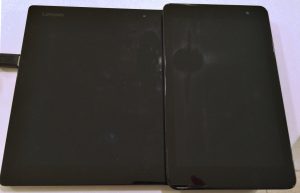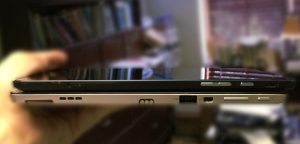The Miix 700 is a Good Size
Moving up from the 8-inch Dell Venue 8 Pro to the nearly 13-inch Lenovo Ideapad Miix 700 was a revelation. Five inches is a lot when you’re talking about tablet screens. In fact, the Miix 700 is almost exactly as wide as the V8P is tall.

The screen is beautifully crisp, colorful, and sharp. Having a full-HD screen in a relatively small display makes for an incredibly pleasing experience. While the V8P was serviceable at browsing the web and reading books on the Kindle client, the extra screen real estate means that reading Word documents and PDFs is pleasant, rather than a laborious chore. The small screen of the V8P meant that I was constantly zooming and panning to read documents, which was far from ideal. That doesn’t happen with the Miix 700. I can read documents in full-screen mode, and it’s essentially equivalent to reading on a standard sheet of paper.
Incredibly Thin and Light
Apple crows a lot about how thin its devices are, and they are. But Apple certainly doesn’t have a monopoly on thin and light devices. The Miix 700 is barely, if at all, thicker than the Venue 8 Pro.

Though it’s quite thin, it feels light in the hand, and the build quality is reassuringly sturdy.
An Initial Sense of Dread
I didn’t get to really play with the device the first day I bought it, a Saturday, since family obligations took precedence (as they do). But the following morning, I got to work setting it up. As it booted, I smiled at how quickly (about 5 seconds) it went from the Lenovo splash screen to the set up page.
(I’m old enough to still be astounded by what modern devices are capable of. My first exposure to computers was way back in the Apple IIe era. The first MS-DOS-based computer I used was my father’s 8088-based green screen beast with a whopping 4 MB of RAM. The computer I took to the University of Texas when I was a freshman was a 486 I built myself, which featured a ginormous 1GB hard drive. That hard drive was purchased for the low, low price of $100 on sale. Cold-booting into Windows 95 meant having plenty of time to go take a shower before everything got settled in.)
Choosing all the appropriate settings and credentials was easy enough, and Windows 10 helpfully sought out a few updates it needed to install, and it got to work. Within approximately 30 minutes, the OS had installed, and it was just going through the last steps before logging in completely. Here, I’m a little hazy about what happened next.
I can’t fully remember if auto-rotate worked immediately out of box, or if it stopped working after I went to Lenovo’s site and downloaded updated drivers and BIOS updates. But at some point early that Sunday morning, auto-rotate didn’t work. Sure, I was able to go into the display settings and change the orientation manually. But that’s cumbersome and far from ideal. A sense of dread washed over me as I rebooted the device and still it didn’t rotate automatically.
Blow it Out of the Water
Since I hadn’t installed anything but a few drivers, I decided to wipe the system and start over. Which is really easy to do in Windows 10. You simply click on the Action Center icon on the bottom right of the screen, click “All Settings,” click “Update & security,” click “Recovery,” and then click “Reset this PC.” (Or something like that. I’ve upgraded to the Anniversary Update on all my devices–more on that in a bit–and things have changed slightly. But the general gist is appropriate.)
That…did nothing for me. While it didn’t take long at all, it didn’t fix the problem.
So, like a bad scientist, I tried two things at the same time. First, I redownloaded some display drivers from Lenovo, and I hunted down the Anniversary Update Update Assistant from Microsoft (look for the link just below the picture of the 2-in-1s) to force the upgrade, even though I knew that there have been a lot of issues with it. (Funny joke: Microsoft says “Windows 10 has some new features and surprises.* I like to think the asterisk links to a disclaimer saying that–surprise!–updating might kill your web cam…)
That process is dead simple, and the upgrade took very little time. Perhaps 45 minutes from download, install, reboot, and finally logging back in to a working environment. (This was in line with how long it took on my Envy 15, but when I finally forced the upgrade on my desktop machine at work, the entire process took more like 5 hours. YMMV, in other words.)
If this didn’t work, I was pretty much out of ideas. I had very little stomach for the prospect of spending hours scouring the web for help on a product which does not have wide adoption. And I figured whatever “fixes” might be found would likely not be very helpful anyway. I promised myself that–regardless of the fact that I wanted to love the bargain I had found and regardless of how much potential I saw in the device–if auto-rotate didn’t work, it would be going back to Microcenter.
Hallelujah, the Miix 700 Does What a Tablet is Supposed to Do
Whether it was redownloading the display drivers or installing the Anniversary Update that finally made everything work, I don’t know. All I know is that when the desktop came back up after the installation, the screen rotated. By itself.
 Probably due to patent issues, Windows devices handle rotation in a unique manner. For example, iOS devices rotate smoothly from portrait to landscape mode, while Android devices–circa 2012–chunkily “blinked” from portrait to landscape (I don’t really know how they handle it these days…). Windows devices, though, do this thing that’s a little reminiscent of breathing. The screen shrinks a little, blinks, and then expands back into place. In any event, rotation works.
Probably due to patent issues, Windows devices handle rotation in a unique manner. For example, iOS devices rotate smoothly from portrait to landscape mode, while Android devices–circa 2012–chunkily “blinked” from portrait to landscape (I don’t really know how they handle it these days…). Windows devices, though, do this thing that’s a little reminiscent of breathing. The screen shrinks a little, blinks, and then expands back into place. In any event, rotation works.
Next time: Using the Miix 700 with a Stylus.
